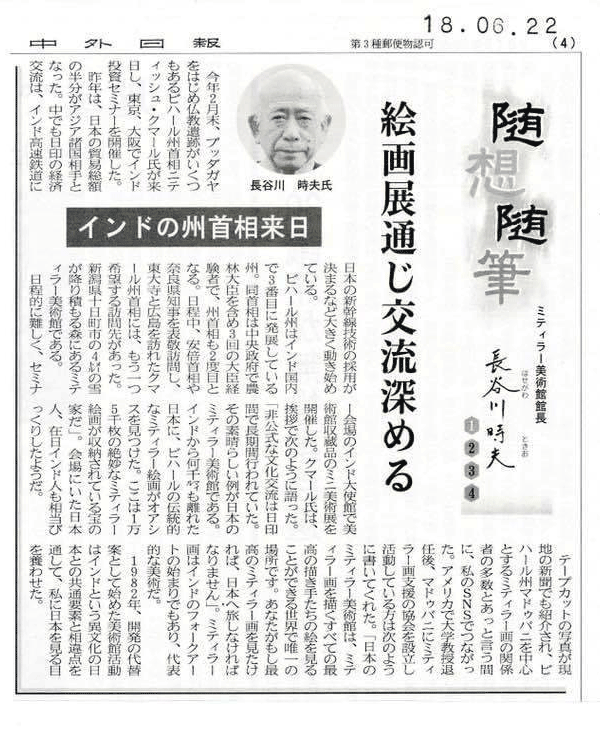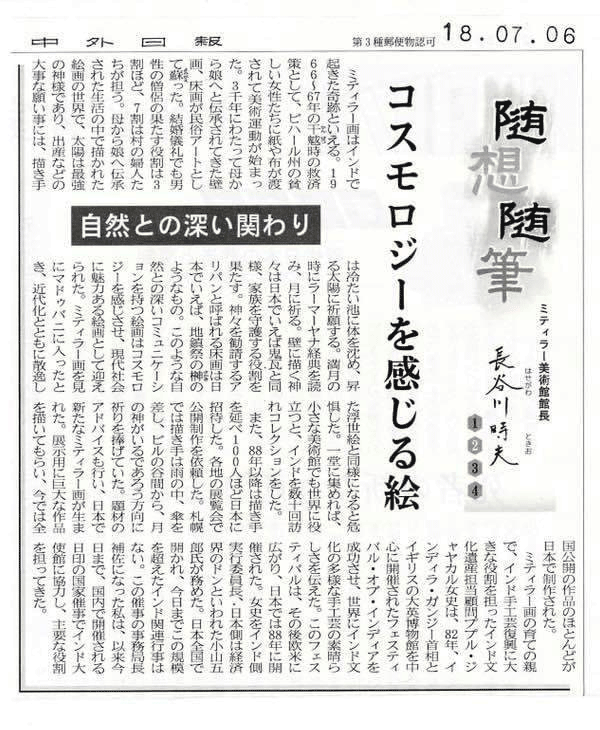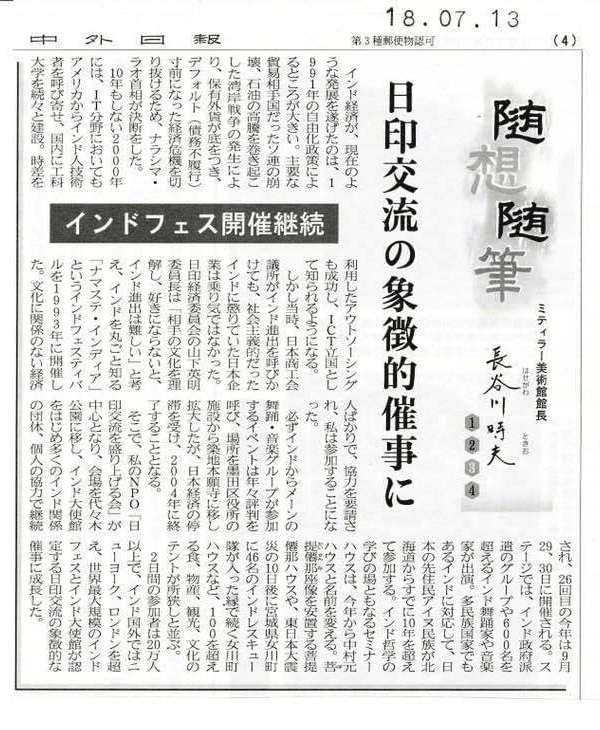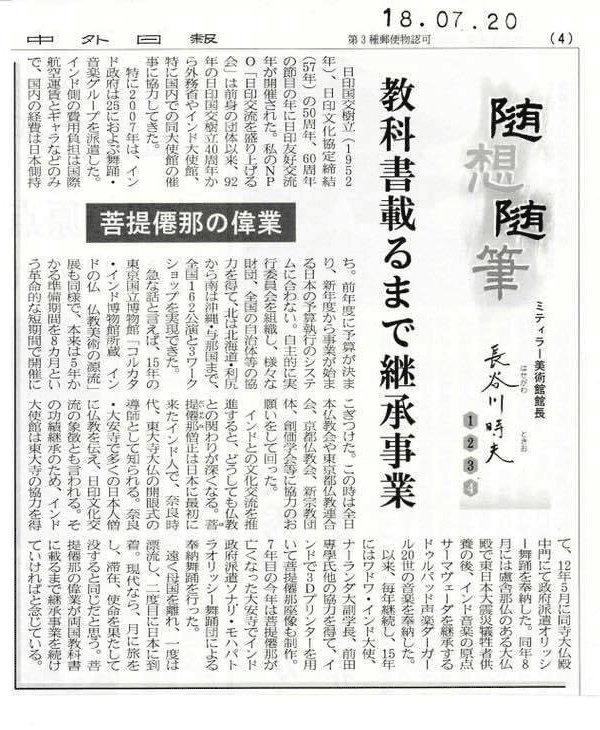Chugai Nippo (22 June, 2018) Tokio Hasegawa, Director, Mithila Museum
Column "Random Thoughts and Random Essay 1": "Bihar State CM Visited Japan:Deepened Relationship Through the Exhibition of Mithila Arts"

At the end of February this year, Mr. Nitesh Kumar, the Chief Minister of Bihar, India visited Japan. Bihar is an Indian state, known to have many Buddhist sites. During his stay in Japan, he organized investment seminars in Tokyo and Osaka.
Last year, Japan's trade with Asian countries grew to significantly to occupy the half of the entire trade value, making them Japan's major trade partners. While many Asian countries enjoyed robust economic relation with Japan, the economic relation between Japan and India gained momentum when it was decided that India would adopt Japan's Shinkansen system to country's first high-speed railway project.
Bihar is the third most developed Indian state. Mr. Nitesh Kumar, Bihar's CM, is an experienced politician who has served as cabinet minister for three times, including the Minister for Agriculture and Forestry. And this is the second time for Mr. Kumar to serve as Bihar CM. During his stay in Japan, he called on PM Abe and Nara Governor. He also visited Todaiji Temple in Nara and Hiroshima. There was one more place in Japan he wished to visit. That was my museum; the Mithila Museum which is located in a wood in Tokamachi-shi, Niigata Pref. This is very snowy region that the museum would covered with four-meter snow in the winter.
His wish to visit my museum was not possible due to other official engagements, so l decided to organize a mini exhibition of Mithila Collection at the Embassy of India, Tokyo. which was one of the seminar venues. Mr. Kumar said in his speech that unofficial cultural exchange had been implemented for a long time and Mithila Museum was a wonderful representation of such efforts. He said "Mithila art, the traditional art of Bihar. an oasis in Japan, thousands of miles away from its home. This museum is like a full-house filled with precious gems*. Japanese and NRI seemed to be stunned to learn about the volume and the value of artworks kept at the Mithila Museum.
After the photo of CM attending the tape cutting ceremony for the mini exhibition at EOl was published by local newspapers in Bihar, I was able to get acquainted with many persons mainly based in Madhubani, Bihar who engage in activities related to Mithila art. A person who established an association in Madhubani to support Mithila art and artists wrote to me, praising my museum as "the sole place in the world where one can see works of the best Mithila artists of all". He also wrote that if one wished to see the best Mithila arts, s/he should travel to Japan. For me, Mithila art is the origin of India's folk art and is the art representing India.
I opened the Mithila Museum in 1982 as an alternative development plan to save the old elementary school building and the surrounding environment. The initial intention to open the museum was to preserve indian folk arts, but the museum actually helped me to better understand my own country by highlighting common cultural aspects between Japan and India, which have totally different culture.
Chugai Nippo (6 July, 2018) Tokio Hasegawa, Director, Mithila Museum
Column "Random Thoughts and Random Essay 2": "Deep Relation with Nature: Felt Cosmology from India's Folk Art”

I believe that Mithila art could be called India's miracle. During the drought that Bihar suffered from 1966 to 1967, the state government launched art movement as a part of effort to save farmers from the devastation. The state distributed papers and cloths to women in farming villages and encouraged them to create art works. This art movement gave a chance for wall and floor painting which method had traditionally been passed down from mothers to their daughters in the region for over three thousand years to reemerge as folk art. In rural villages of Bihar, women have played central roles in various rituals. In the wedding ceremony in rural villages, men, in this case priest, may contribute to 30% of the entire ceremony, while the rest was implemented by village ladies. In the traditional art of Mithila, which has been passed down from mothers to their daughters, the Sun is the Supreme Being. When a painter is to create a painting to pray for important occasions, like safe delivery of a baby, the Mithila painter may purify him/herself by bathing in cold water and offer prayer to the rising sun before start painting. When it's full moon, painters may read Ramayana and offer prayers to the moon. It's common practice for them to draw images of gods on the outside walls of houses in order to protect them from evil spirits. Similarly, Japanese houses may have Onigawara, a decorative roof tile, placed on the edge of the roof to drive evil spirits away. The floor painting in the region is called Aripan and it is drawn in order to welcome the gods. Aripan can be said as Japan's sakaki plant which is offered to the gods. From Mithila art, which indicates deep relationship between the people and the nature, one may feel cosmology from it. And this Indian art form was accepted by the modern society with open arms. When I visited Madhubani to learn more about the Mithila art, I felt the fear that this art form may follow the same history as Japan's Ukiyoe which were lost as Japan was modernized. I decided to collect as many of them as possible, believing that even a small-size museum like mine could make some kind of contribution to the world. I have visited India dozens of times to gather this precious art form.
In 1988, I started new attempt. Since 1988, I have invited over 100 Mithila artists to Japan. During their stay. I requested them to perform painting in front of Japanese people at exhibitions I organized across Japan. When we traveled to Sapporo with a Mithila artist, it was raining. Even in the rainy weather, the artist did not forget to offer prayer to the direction which the moon may have been shining behind the thick rain cloud with an umbrella in his/her hand. I gave advices to artists on what to draw and many new works were born in Japan. I also requested them to create large art works during their stay in Japan. As a result, many large-size Mithila paintings were created here in Japan and they are entertaining Japanese audience.
Smt. Pupul Jayakar, the Indian Cultural Heritage Advisor, who fostered the Mithila art and played a major role in revitalizing Indian handicraft, successfully organized the Festival of India in 1982, together with then the Prime Minister of India, Smt. Indira Gandhi. The festival was held at various places including the British Museum and revealed the wonderful world of Indian handicrafts and its diversity to the world. After the success in 1982, the festival was held in various places in Europe and US and then came to Japan in 1988. An executive committee was organized in order to implement the festival. Smt. Jayakar was the Indian committee chairperson and Mr. Goro Koyama, who was the most powerful figure in the economic circle at the time, was the Japanese counterpart. The festival was held at various places in Japan. There have been no other India-related events which match the scale of the Festival of India in 1988. I am proud that I was a part of this effort to organize the Festival of India in Japan as the Deputy Secretary General. Since then, I have played major roles in organizing various joint national events between Japan and India in Japan while closely cooperating with the Embassy of India, Tokyo.
Chugai Nippo (13 July, 2018) Tokio Hasegawa, Director, Mithila Museum
Column "Random Thoughts and Random Essay 3": "Continuation of the Festival of India in Japan: Later Became the Symbol of the Japan-India Exchange”

It has to be said that the economic liberalization policy of 1991 played major role in forming today's Indian economy. Then the Prime Minister of India, Narasimha Rao made a historical decision to open up the Indian economy which faced with the possibility of default. At that time, India lost much of foreign reserves due to the collapse of USSR, India's major trading partner at the time, and the boiling oil price triggered by the Gulf War.
By 2000, India emerged as ICT country, in less than 10 years from the economic liberalization. India called Indian IT engineers back from US and established technology universities inside the country one after another. It became successful in the outsourcing business by taking advantage of the time differences between India and countries of client companies.
However, Japanese companies were very much reluctant to the call by the Japan Chamber of Commerce and Industry to enter Indian market because they had bitter experience with India which used to be a socialist country. Mr. Hideaki Yamashita, then the Chairman of the Japan-India Business Co-operation Committee, organized an Indian festival named "Namaste India" to provide opportunity for Japanese and Japanese companies to learn about India, believing that it would be difficult to enter India without understanding and liking its culture. I was requested to support the effort by JIBCC as many of them were business persons who had no knowledge in Indian culture or organizing cultural events.
I suggested JIBCC to invite dance troupe or musicians from India as main attraction of the festival. Initially, the Namaste India was held in a facility of Sumida Ward but as the festival became popular, we had to shift the venue to Tsukiji Hongwanji Temple to accommodate the increased number of visitors. However, JIBCC decided to stop it in 2004 when Japanese economy started to stagnate.
I decided to continue JIBCC's effort by establishing my own NPO, the Society to Promote India-Japan Cultural Relations. My NPO became the main organizer of the Namaste India. We shifted the venue to Yoyogi Park in Tokyo. Because of the generous support and cooperation from the Embassy of India, Tokyo, various India-related organizations and individual persons, we were able to continuously organize the festival. We will be organizing the 26th Namaste India on 29th and 30th September this year. There will be performances by 600 dancers and musicians, including dancers or musicians dispatched by the Indian Government. As India is the diverse culture, we invited Japan's minority tribe in Hokkaido, the Ainu, to perform at the Namaste India. They have participated in the festival for over a decade now. We have had a seminar house at the Namaste India where people can learn about Indian philosophy. This year, we decided to name it as Hajime Nakamura House, after the late prominent Indian researcher, Dr. Hajime Nakamura. In addition, we have over hundred booths introducing Indian cuisine, commodities, tourism and culture. At the festival venue, we also have a special house dedicated to Bodhisenna, an Indian monk who came to Japan as the first Indian. In the Bodhisenna house, we have the statue of Bodhisenna on display during the festival. Moreover, Onagawa City sets up a booth at the festival. In March 2011, 46 members of India's rescue team went to Onagawa City and engaged in rescue operation there.
We have about 200,000 visitors throughout this two-day festival. Namaste India is now recognized as the world largest Indian festival by EOl, surpassing those organized in New York and London in scale, and has become the symbol of Japan-India relations.
Chugai Nippo (20 July, 2018) Tokio Hasegawa, Director, Mithila Museum
Column "Random Thoughts and Random Essay 4": "Determined to Continue Effort to Spread the Achievement of Bodhisenna Until It Appears in Japanese and Indian History Textbooks”

Japan-India Friendly Exchange Year programs were implemented at memorial years of two countries. The first one was held in 2002 when we celebrated the 50th anniversary of the establishment of Japan-India diplomatic ties (1952). And second one was held in 2007, to commemorate the 60th anniversary of the conclusion of the Japan-India Cultural Agreement. My NPO, the Society to Promote India-Japan Cultural Relationship. has cooperated with MOFA and the Embassy of India, Japan since 1992, when Japan and India celebrated the 40th anniversary of the establishment of the diplomatic ties. Especially, we have been closely working with EOl. Tokyo when it organizes events in Japan.
We worked very closely especially in 2007, when Indian Government dispatched 25 dance and music troupes to perform in Japan. Indian side paid for the international airfare and performance fee for the artists, but not all expenses occurred in Japan, such as accommodation and transportation. However, in Japan where all budgetary arrangement for a current fiscal year is made during the previous fiscal year, it was all too late to secure enough funds for the programs. We managed to implement 162 stage performances and three workshops in various places in Japan, from Rishiri, Hokkaido in the north to Yonaguni, Okinawa in the south by establishing an executive committee to make all necessary arrangements and by requesting various Japanese foundations and municipal governments across Japan to extend support to our efforts.
The other memorable event which proposal came all too sudden was "Indian Buddhist Art- from Indian Museum, Kolkata" held in 2015 at the Tokyo National Museum. Usually, it takes about five years to organize an exhibition at the national museum, but we managed to do so in eight months. It was a revolutionarily short preparation time. In order to make the exhibition successful, I visited various Buddhist and religious organizations, including the Japan Buddhist Federation, the Tokyo Buddhist Federation, the Kyoto Buddhist Organization and Soka International, requesting their supports to the exhibition.
When promoting the cultural exchange with India, it is unavoidable to develop deep relationship with Buddhism. Bodhisenna is the first Indian who came to Japan. He is known to have conducted the consecration ceremony for the Great Buddha statue at the Todaiji Temple of Nara in 752. He taught Buddhist discipline to many Japanese monks at Daianji Temple in Nara and is called the symbol of Japan-India cultural exchange. In order to pass on his achievement to the future, the Embassy of India, Tokyo in May 2012 dedicated the Odissi dance performance by the dance troupe dispatched by the Government of India at Chumon Gate at Todaiji Temple. In August same year, the embassy dedicated Dhrupad, India's traditional vocal music, performed by Dagar XX who is the successor of Samaveda, the origin of Indian music. The performance was given at the Daibutsuden Hall at the Todaiji Temple where the Great Buddha is housed after the memorial service for the victims of the Great Eastern Japan Earthquake.
Since then, we have continued our effort to pass on what Boddhisenna achieved in his life. In 2015, with the cooperation from then the Ambassador of India to Japan, Mrs. Wadhwa, the Vice President of Nalanda University, Dr. Sengaku Mayeda and many others, we created a statue of Boddhisenna using 3D printer. This year, we organized an Odissi performance by Sonali Mohapatra Odissi Dance Troupe which was dispatched by the GO at Daianji Temple where Boddhisenna passed away,
Boddhisenna travelled far away from his home to reach Japan. In his first attempt, his ship got adrift. He finally reached Japan at the second attempt. In modern times, Boddhisenna's journey to Japan is like travelling to the moon, staying there to complete a difficult mission and returning home to rest. I always tell myself that it is my mission to continue my effort until Boddhisenna's achievement is stated in history textbooks in Japan and India and become well-known to the people of both countries.
|
|